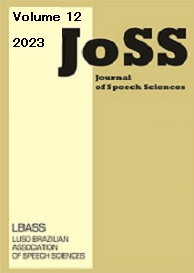Abstract
This study explores the third language imitation of the Spanish rhotic-lateral contrast by Akan-English bilingual children and adults. Specifically, it examines this phenomenon, with respect to (i) first language transfer in the imitation of the Spanish rhotic-lateral contrast, (ii) the effect of orthographic input on the imitation of the rhotic-lateral contrast in Spanish as a third language, and (iii) the effect of age of acquisition with the inclusion of a comparison between children and adults. Whereas rhotics and laterals are contrastive in most varieties of Spanish and English, they are in free variation in Akan (Guerini, 2018). The participants in this study consisted of 20 Akan-English bilinguals between the ages of 8-10yrs and 18-55. The conditions included an imitation task with auditory input only and another with orthographic input. The results showed evidence of L1 transfer, a positive effect of orthography, and a better performance of children. This study has important implications as it provides data from an understudied population in the field of L2/L3 speech learning.
References
Abakah EN. Where have all the consonantal phonemes of Akan gone? Journal of Philosophy and Culture. 2004: 1: 2: 21-49.
Abakah EN. Hypotheses on the diachronic development of the Akan language group. Journal of Universal Language. 2016: 17: 1: 1-51.
Adjave SA. Ghanaian English pronunciation. Edwin Mellen Press, 2005.
Appah CK. Nominal derivation in Akan: A descriptive analysis. [Unpublished doctoral dissertation]. Norwegian University of Science and Technology, 2003.
Bassetti B. Orthographic input and second language phonology. Input Matters in SLA. 2008: 191-206.
Bassetti B. Orthography affects second language speech: Double letters and geminate production in English. Journal of Experimental Psychology: Learning, Memory, and Cognition. 2017: 43: 11: 1835-1842.
Bassetti B, Mairano P, Cerni T. Effects of orthographic forms on second language speech production and phonological awareness with consideration of speaker-level predictors. Language Learning. 2020: 70: 4: 1218-1256.
Chih MT. E/LE en Taiwán: Problemas de apreciación fonética en estudiantes universitarios de grado. Revista de enseñanza de ELE a hablantes de chino. 2013.
Colantoni L, Steele J. Integrating articulatory constraints into models of second language phonological acquisition. Applied Psycholinguistics. 2008: 29: 3: 381-406.
Dako K. Some thoughts about the use of dental fricatives by students at the University of Ghana. Ghana Journal of English Studies. 2000: 2.
Dolphyne FA. The Akan (Twi-Fante) language: Its sound systems and tonal structure. Ghana Universities Press. 1998.
Erdener VD, Burnham DK. The role of audiovisual speech and orthographic information in nonnative speech production. Language Learning. 2005: 55: 2: 191-228.
Escudero P. Orthography plays a limited role when learning the phonological forms of new words: The case of Spanish and English learners of novel Dutch words. Applied Psycholinguistics. 2015: 36: 1: 7-22.
Face TL. Intervocalic rhotic production by adult learners of Spanish as a second language. Selected Proceedings of the 7th Conference on the Acquisition of Spanish and Portuguese as First and Second Languages. 2005: 47-58.
Flege JE, Frieda EM, Nozawa T. Amount of native-language (L1) use affects the pronunciation of an L2. Journal of Phonetics. 1997: 25: 2: 169-186.
Guerini F. It sounds like the language spoken by those living by the seaside-language attitudes towards the local Italo-Romance variety of Ghanaian immigrants in Bergamo. International Journal of the Sociology of Language. 2018: 2: 54: 103-120.
Hayes-Harb R, Cheng HW. The influence of the Pinyin and Zhuyin writing systems on the acquisition of Mandarin word forms by native English speakers. Frontiers in Psychology. 2016: 7: 1-13.
Johnson KE. Second language acquisition of the Spanish multiple vibrant consonants. The University of Arizona. 2008.
Kpogo F, Gathercole VCM. The influence of native English-speaking environment of Akan-English bilinguals’ production of English inter-dental fricatives. International Journal of Bilingualism. 2019: 24: 24: 559-571.
Marian V, Blumenfeld, HK, Kaushanskaya M. The language experience and proficiency questionnaire (LEAP-Q): Assessing language profiles in bilinguals and multilinguals. Journal of Speech, Language, and Hearing Research. 2007: 50: 4: 940-967.
Nikolv M, Djigunovic JM. Recent research on age, second language acquisition, and early foreign language learning. Annual Review of Applied Linguistics. 2006: 26: 234-260.
Ngula RS. Ghanaian English: Spelling pronunciation in focus. Languages in India. 2011: 11: 2: 22-36.
Olsen MK. The L2 acquisition of Spanish rhotics by L1 English speakers: The effect of L1 articulatory routines and phonetic context for allophonic variation. Hispania. 2012: 65-82.
Ortí Mateu R. Comparación fonética, diagnóstico y tratamiento de las dificultades de los estudiantes chinos para aprender español. [Unpublished doctoral dissertation]. 1990.
Patience M. Acquisition of the tap-trill contrast by L1 Mandarin-L2 English-L3 Spanish speakers. Languages. 2018: 3: 4: 42.
Patience M, Qian W. The role of task complexity and dominant articulatory routines in the acquisition of L3 Spanish. Languages. 2022: 7: 2: 90.
Paradis M. A neurolinguistic theory of bilingualism. John Benjamins Publishing, 2004.
Rafat Y. The interaction of acoustic and orthographic input in the acquisition of Spanish assibilated/fricative rhotics. Applied Psycholinguistics. 2015: 36: 1: 43-66.
Rafat Y. Orthography-induced transfer in the production of English-speaking learners of Spanish. The Language Learning Journal. 2016: 44: 2: 197-213.
Scovel T. A time to speak: A psycholinguistic inquiry into critical period for human speech. NY: Harper and Row, 1988.
Waltmunson JC. The relative degree of difficulty of L2 Spanish /d, t/, trill, and tap by L1 English speakers: Auditory and acoustic methods of defining pronunciation accuracy. University of Washington. 2005.
Wang D, Nance C. Third language phonological acquisition: Understanding sound structure in a multilingual world. Language and Linguistics Compass. 2023: 17: 5.
Yeni-Komshian GH, Flege JE, Liu S. Pronunciation proficiency in the first and second languages of Korean-English bilinguals. Bilingualism: Language.

This work is licensed under a Creative Commons Attribution 4.0 International License.
Copyright (c) 2023 Linda Ahima, Gabriela Martinez Loyola, Laura Spinu, Yasaman Rafat


